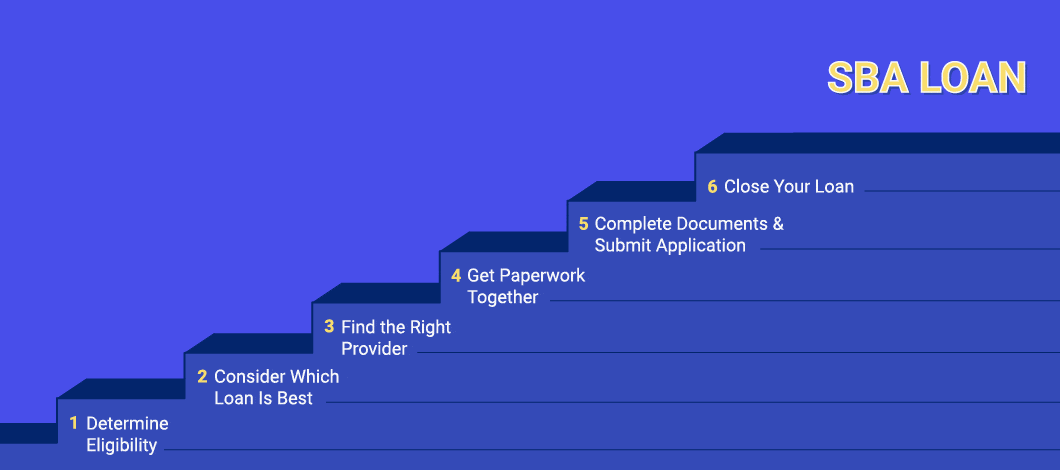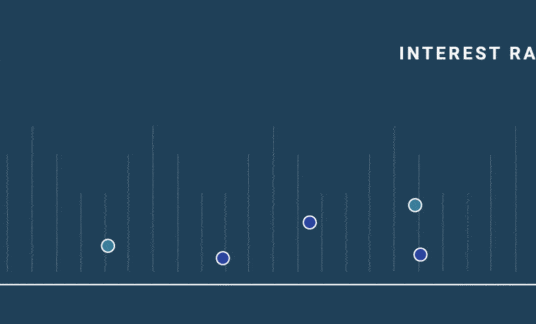Securing capital for business expansion is a problem that plagues many small business owners. Fortunately, a Small Business Administration (SBA) loan can help you bridge the gap in your company’s finances.
6 Steps to the SBA Loan Process
Applying for SBA loans can be broken down into the following 6 steps.
1. Determine Your Eligibility
The first step for how to get approved for an SBA loan is to figure out if you qualify.
Sound finances and a fair-to-good credit score are essential for those wondering how to obtain a small business loan from the SBA. Minimum credit scores for an SBA loan can fall between 620 and 650, depending on the lender. You’ll also need to have collateral for your loan and be prepared to give a personal guarantee from every owner who owns at least 20% of the business.
Furthermore, SBA 7(a) loan requirements dictate that you have to:
- Be a small business
- Be a for-profit business
- Do business in the United States
- Have invested equity
- Have exhausted financing options
- Have been in business for more than 2 years
As there are many eligibility requirements, speak with your lender to see if you qualify.
-
Do You Qualify to Get an SBA Loan?
Through Fast Capital 360’s SBA lending partners, you are likely to qualify for a loan if you meet the following requirements:
- Been in business 2 years or longer
- Generate $50k in annual revenue
- Have a credit score of 650 or better
2. Consider Which SBA Loan Type Is Best for You
There are several different types of SBA loan, each with its own loan requirements, rates and terms. So you’ll need to figure out which one would best meet your business financing needs. Here’s an overview some of the most popular options:
| SBA Loan Type | Maximum Loan Amount | Use of Funds | Terms |
| Standard 7(a) | $5 million | Working capital, facilities, equipment, inventory | 10 years for working capital or fixed assets; 25 years for real estate |
| SBA Express | $500,000 | Same as standard 7(a) | May be used as term loan with terms the same as 7(a) or as a line of credit up to 7 years (with maturity extensions permitted at the outset) |
| SBA CAPlines | $5 million | Different credit lines available depending on needs: seasonal, contract, building and construction and working capital | 10 years, except Builders CAPline, which can’t exceed 5 years |
| CDC/504 | $5 million (CDC portion) | Long-term fixed assets | 10, 20 or 25 years |
| Microloan | $50,000 | Working capital, inventory, equipment, supplies, fixtures | Not to exceed 6 years |
3. Find the Right SBA Loan Provider
One common misconception is that the SBA provides loans, which isn’t the case. For most programs, an SBA-approved lender finances the loan and the SBA guarantees a portion of the loan, up to 90% in some cases. An SBA loan guarantee equates to less risk for lenders and favorable borrower terms.
It’s crucial to look for a lender that has experience with SBA loans. There are some questions you should ask, such as:
- Is this provider familiar with your industry?
- Do they dedicate themselves exclusively to SBA loans?
- What types of SBA loans do they offer?
- Are they easy to communicate with?
- What are their average SBA loan interest rates?
- What are their average SBA loan sizes?
4. Get Your Paperwork Together
Be prepared to submit a great deal of paperwork when you’re applying for an SBA loan. Start collecting these items as soon as you know you’re eligible for the loan:
- Resume
- Personal background statement
- Business plan, which should build an argument for how you’ll repay the loan
- Financial statements, including profit-and-loss statements
- Detailed information about how you plan to use the loan
- Credit reports, both personal and business
- Income tax returns, both personal and company, for the past 3 years
- Legal documents as they relate to the company, such as leases, business licenses, articles of incorporation, etc.
- Proof of collateral
While this may seem like a long list, in reality, it isn’t exhaustive. (Remember, the process is quite involved.) Additionally, if you have business partners, you need to make sure everyone is on board since you’ll all have to submit documentation.
5. Complete SBA Loan Documents and Submit Your Application
Once you’ve gathered your business paperwork, it’s time for the SBA forms. The primary documents needed for an SBA loan include:
- SBA Form 148: This document is needed to offer a personal guarantee.
- SBA Form 1919 (borrower information form): This form is used to check business eligibility.
- SBA Form 413 (personal financial statement): This form asks for details about each owner’s household assets and liabilities. It can be complicated to fill out, so make sure you know what you need to complete Form 413.
- SBA Form 159 (protects borrowers from unnecessary fees): You may or may not need to complete this.
- SBA Form 912 (statement of personal history): Fill out if you have a criminal history. Having a criminal past doesn’t disqualify you automatically. The SBA will decide your case individually.
6. Close Your Loan
Once you submit your SBA loan package, it’s time to wait and see. If the lender decides to move forward with your application, you’ll receive a letter of intent usually within a couple weeks. This will include mention of the loan amount you’ve prequalified for as well as an estimate of loan terms and interest rate. If you’re in approval with the terms, you may need to provide a deposit to continue on with the process.
Next, the loan application will be sent to underwriting, which could take a month or so to complete. You may be asked for additional financial documents at this time. Upon underwriting approval, you’ll be sent a business loan agreement detailing the final terms, loan amount and interest rate. You’ll need to sign this agreement to accept the offer and pay your closing costs to seal the deal.
How Hard Is it to Get an SBA Loan?
SBA loans and lines of credit have the highest application rate among small business firms, specifically 44%, according to the Federal Reserve Banks’ 2022 Small Business Credit Survey. Not surprisingly, many small business owners wonder how hard it is to get an SBA loan. It’s important to know the process involves a lot of paperwork and there are many requirements needed to secure a small business loan of this type.
If you plan to apply for an SBA loan, consider the loan you’re applying for, whether a microloan, SBA 7(a) loan or 504 loan. Be aware that the process can be complicated and it may be hard for certain individuals and businesses to be approved.
You may have trouble securing a small business loan if you have less than ideal credit, your business hasn’t been running for very long, your annual revenue is low or you have no business plan.
These loans aren’t meant for struggling businesses either, and you may run into issues if you’ve defaulted on a student loan or have a criminal past.
But the good news is, if you have good credit, your annual revenue is in good shape and you meet qualification requirements, you exhibit the characteristics of a strong candidate.
Related: What Credit Score Do I Need to Qualify for a Small Business Loan
Does Getting an SBA Loan Take a Long Time?
The amount of time it takes to finalize an SBA loan varies. Expect the process to take a minimum of 60-90 days. Applications for larger amounts may take longer for the lender to evaluate.
We recommend that you take the time to thoroughly understand all the steps and requirements before you get started. It may be helpful to speak with a loan advisor to get a better picture of how long your timeline will be.
What If My SBA Loan Application Is Denied?
If your SBA loan application is denied, you still have options when it comes to getting a small business loan or accessing funds to grow your company.
Consider crowdfunding, small business grants or online lenders who offer alternative financing options, including:
- Short-term loans
- Business lines of credit
- Merchant cash advances
- Accounts receivable financing
Final Details for How to Get an SBA Loan
Getting a small business loan can be a life-changing milestone for a business owner. Given the importance, be as prepared as possible when trying to get approved for an SBA loan. Follow the steps we’ve outlined above and read our complete guide to small business loan applications. Visit the SBA website too, another great resource that provides further information about how to get an SBA loan.











